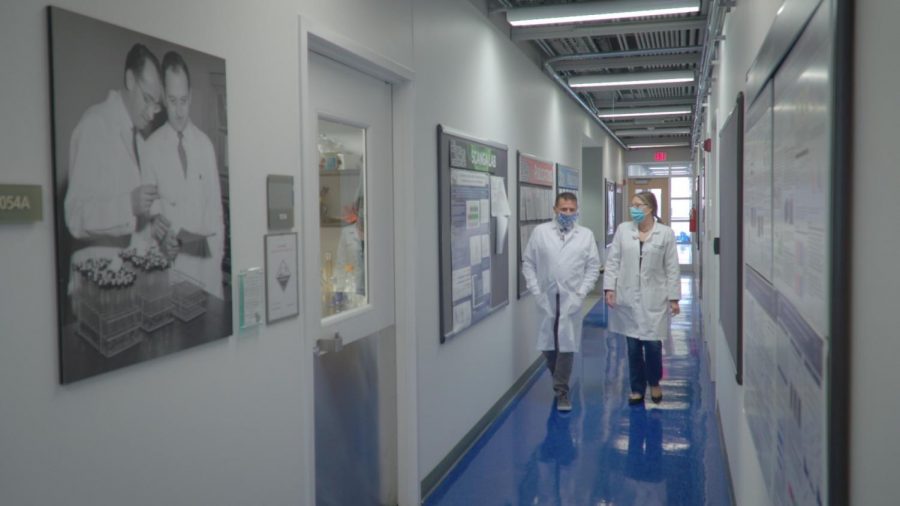‘Filming history’: Documentary features Pitt’s efforts in COVID-19 vaccine research
Image courtesy of Carl Kurlander
The film “CHASING COVID” follows the work of Dr. Paul Duprex and his team in Pitt’s Center for Vaccine Research, where they have been working to uncover new information about COVID-19.
April 21, 2021
While the COVID-19 pandemic is many people’s first experience with a deadly, widespread virus, Carl Kurlander, the director and producer of the newly released “CHASING COVID” film, said it was all too reminiscent of his past experiences documenting the polio virus and the polio vaccine’s creation.
For Kurlander — who saw many parallels from his experience documenting the polio vaccine in the film “The Shot Felt Round the World” — he said there was a lot to learn from experiencing both the COVID-19 and polio crises, which he felt he could best express through a film.
“In March, I noticed the news saying some things that felt all too familiar to my time documenting the polio vaccine such as ‘an invisible enemy that was crippling a nation’ and ‘a terrifying disease,’ which started me on my process to noting the parallels to the search for the polio vaccine and the search for the COVID-19 vaccine,” Kurlander said.
The “CHASING COVID” film, which premiered April 12 — the 66th anniversary of Jonas Salk’s polio vaccine, developed at Pitt — follows the work of Dr. Paul Duprex, director of the Center for Vaccine Research and Jonas Salk chair for vaccine research, and his team in the CVR, where they have been working to uncover new information about the COVID-19 virus. The film follows Duprex as he and his team determine preventative safety measures to mitigate virus spread, COVID-19’s mutations and infectivity and how previous biotechnology can be utilized for the COVID-19 vaccine development.
Kurlander also published an article detailing the importance of the polio epidemic in regards to COVID-19 and was featured in CBS Sunday Morning — along with Duprex — to discuss what he learned from the polio epidemic and how his understanding would help manage the current COVID-19 pandemic.
Besides the release of the film, the University’s Center for Creativity and Allegheny Intermediate Unit is hosting a competition, called Take a Shot at Changing the World, to help inspire middle and high school students to spread compelling and accurate information — similar to the “CHASING COVID” film — about vaccines. The competition opens on April 22 and the deadline is May 30.
Kurlander said the film is important because it is an educational tool for students and teachers to better learn and understand the COVID-19 pandemic, virus and vaccine.
“Our goal was to create an educational, yet also entertaining film that highlighted the science behind the virus and the vaccines, and helped better explain how research is conducted, so that this film can be incorporated into educational curriculums as well,” Kurlander said.
Pitt alumnus Andrew Esper — who graduated with a degree in psychology and film studies — worked as the editor and co-producer of the film in conjunction with Owen Gambill, the assistant editor and a sophomore cinematography and film major. Esper said filming the documentary proved to be a “notable yet unprecedented” experience in his career because the film documented the research in real time as new information about the virus was released.
“As we were working on the project what we knew about the virus was constantly changing, and what we were able to say about the virus was changing, so a huge part of documenting this film was continually updating and trying to capture the literal waves of information and numbers that came through each day,” Esper said.
Esper said he hopes that people watching the film can better understand the science behind vaccine development and the scientists’ immense dedication and collaboration to produce technology that is both safe and effective.
“I would hope that people watching this film understand the effort and science that is required to make these vaccines and realize that there are people on the other end that are dedicating large chunks of their days, evenings and nights into creating this vaccine,” Esper said.
In the film, Duprex detailed the process of receiving samples of the virus in the early stages of the pandemic, and created a doodle that sparked not only the first strategies of how to develop a vaccine against the virus, but also the making of the film. The doodle is a visual effort to better explain how SARS-CoV-2 functions and how a potential vaccine would block the viral infection.

Duprex said while he realizes that COVID-19 might remain for a while longer, the technology created will enable us to better tackle viruses and other deadly diseases in the future.
“Will COVID be here for a while, yes, but will that burden of disease be treated by vaccines, one of the most revolutionary biomedical interventions that we have ever come up with as a society, yes,” Duprex said in the film.
Kurlander said he felt it necessary to produce this film, not because of the pandemic’s historical significance, but also because he wanted to highlight the important and revolutionary work the Center for Vaccine Research does.
“I think Pitt is the only school that can claim to literally have defeated one of the most severe diseases in the last century, and the work that they have done with vaccines is something that needs to be documented for people to see,” Kurlander said.
Owen Gambill is a senior staff videographer at The Pitt News.



